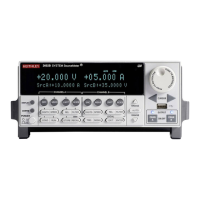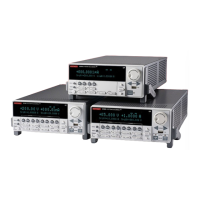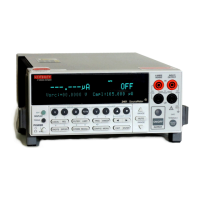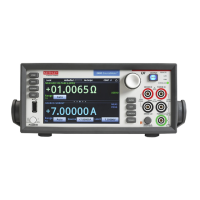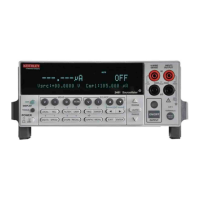Series 2600 System SourceMeters Reference Manual Instrument Control Library 12-21
Return to Section 12 topics 2600S-901-01 Rev. A / May 2006
digio.trigger[N].assert
N is a digital I/O trigger line: 1 to 14
Function Asserts a trigger on one of the digital I/O lines.
Usage
digio.trigger[N].assert()
Remarks The set pulsewidth determines how long the trigger is asserted.
Details See “Controlling digital I/O lines” in Section 10.
Also see digio.trigger[N].pulsewidth
Example
Asserts trigger on I/O line 2:
digio.trigger[2].assert()
digio.trigger[N].clear
N is a digital I/O trigger line: 1 to 14
Function Clears a trigger event on a digital I/O line.
Usage
digio.trigger[N].clear()
Remarks
A trigger’s event detector remembers if a trigger event has been detected since the last
digio.trigger[line].wait call. This function clears a trigger’s event detector and
discards the previous history of the trigger line.
Details See “Controlling digital I/O lines” in Section 10.
Also see digio.trigger[N].wait
Example
Clears trigger event on I/O line 2:
digio.trigger[2].clear()
digio.trigger[N].mode
N is a digital I/O trigger line: 1 to 14
Attribute Trigger operation and detection mode.
Usage
tmode = digio.trigger[N].mode -- Reads trigger mode.
digio.trigger[N].mode = tmode -- Writes trigger mode.
Set tmode to one of the following values:
1 or digio.TRIG_FALLING Input: Detects falling edge triggers.
Output: Asserts TTL-low trigger pulse.
2 or digio.TRIG_RISING Input: Detects rising edge triggers.
Output: Asserts TTL-high trigger pulse.
3 or digio.TRIG_EITHER Input: Detects rising or falling edge triggers.
Output: Asserts a TTL-low trigger pulse.
5 or digio.TRIG_SYNCHRONOUS Input: Detects falling edge-triggers, and then
latch and drive them low.
Output: Asserts a TTL-low trigger pulse.

